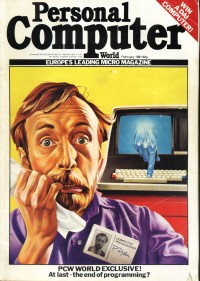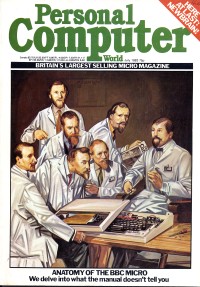2010-04-08»
Guy Kewney»
I don’t know why but from the age of eight to I think fifteen, I just assumed every drawing of a bearded man in or on Personal Computer World was meant to be Guy Kewney. He was the model journalist to me– why wouldn’t he also be the model for all those techies PCW’s graphic editors had to draw?

Not Guy.
As a pre-teen, I was a Personal Computer World kid. I loved the binding, the glossy cover, the thick tall pages, the sprawling reviews, the narrow columns of crazy computer classifieds that would stand like columns over pages and pages and pages of dot-matrix printed listings at the back, the love-hate relationship with the dull business business that would dog it into the grey IBM years, the arty covers, the bearded pundits. But most of all I loved reading Guy Kewney, the beardyist pundit of all.
Cromemco and Nascom, Siriuses and Osbornes. They seemed like far-off planets, and Kewney seemed like some pipe-smoking Dan Dare, giving a jocular downbeat debriefing in the mess, of his latest voyages with the Osborne or the COSMAC ELF, even when the most exciting software they did was inventory management. Kewney made even dull corporate machinations the stuff of high drama.
Aged 10 or 11, I would run around the house playing these elaborate fantasy games, muttering under my breath stage directions, and leaping from chair to chair in our living room. My adventures were set — and I am not joking here — in a 21st century where Apple-IBM and Sinclair-Acorn would heroically battle as giant zaibatsu corporations flying amazing robot battalions around in space. The dramatic climax would always involve me, as the captain of the flagship of the corporate fleet, controller of the inventory, master of the Science of Cambridge, shouting some secret password that would override all the command centers of the opposing army. My favourite Words Of Power in these fantasies was Angelo Zgorelec!, the mystical founder of PCW, whose name appeared on every issue’s masthead, and who I imagined to be a Tharg-like being of supreme wisdom (and great aural resonance).
But the person from whose writing I drew the strategies and the battles and the drama of those corporate tussles was Kewney.

Also not Guy.
I still remember one of his columns. In it, Kewney, boggling at the effort to which software publisher Acornsoft had gone to copy-protect software , published the one-line command for rendering its primitive DRM completely useless. I don’t remember the details, but I do recall just stopping and staring and then laughing and rocking in glee at the audacity of it, and wondering why no-one ever said all those other hidden incantations that I was sure existed out loud in other newspapers and magazines. Then I watched him defend his decision after a barrage of outraged readers (swamped by those who cheered him on) chastised him the next month. It really stuck in my mind as this example of the power of words to unwind elaborate but unsustainable practices.
John Lettice says in his obituary that PCW had to pay Acorn for that Kewney column. They shouldn’t have. And if they had to because of the law, well then, the law was wrong: spelling out these magical words of power, causing corporate battalions to flash out of existence at a single, carefully-researched command, really was Kewney’s job, and he did it masterfully.
I met him once. I’d just started writing for PCW myself, in about 1990, only to discover that my rapid promotion to the flagship of the British tech mag fleet was because they’d sacked all the old guard in a labour dispute and were desperate to fill those gaping pages with cheap young new writers. I tagged along to some press conference and actually overhearing David Tebbutt or Christopher Bidmead or some other Elder God complaining loudly about the wide-eyed children who had stolen everyone’s jobs, yet wouldn’t stop babbling about how honoured they were to meet them.
After that, I always averted my eyes and ceased to bother the titans. When I finally met Kewney, I think I just stood awkwardly by his side, surely making him even more uncomfortable than he must have been.
Or looked. To me, some idiot kid, he did not look well. When I said this to equally squeaky kid co-worker, they told me he had always looked ill, a boney, pale man who was constantly being stabbed with allergies and posture problems, aches and pains and deadlines and all-nighters, triumphing over the all to file his copy mere hours before printers might knock down his door and wring his neck.
I found this hard to believe, because he always looked so erect and noble in his byline pictures. Also in all those cover paintings of him. And in those games where he flew across the corporate landscape, making the world change with a word or two. It just made him seem all the braver.
Now Guy Kewney is gone, and I have this beard, but the words of power are all gone too. And frankly, I do not feel too well myself. Timor mortis conturbat me.
5 Comments »
2010-04-06»
brother against brother»
Oh, but I hate it when the Internets fight! The argument rending my family — and you are all family, to me — it seems so unnecessary. Right now, it is broadly missummarised as: a) you hate my iPad because you’re old geeks who can’t get hep and want all my family to struggle with the command line, and b) you love your iPad because you HATE FREEDOM and are TOO DUMB to OPERATE a PROPER MANUAL LOOM and are Steve Job’s LITTLE CONSUMERIST POODLE THE SIZE OF WILLIAM GIBSON’S BABY HIPPO.
Here’s how to end this pain. Imagine an iPad. It’s the same iPad, built by Jobs and Ives and the rest of Apple in absolute secrecy, beholden to no-one, built on proprietary MacOS and unicorns and last Xerox Silmaril’s gleaming. It has the same Apple App store, same SDK, same no filing system, same no multitasking, same whatever. Only buried deep in the Settings, buried under “Battery Percentage”, “Factory Reset”, there’s an option that says “Allow Third-Party Applications”. Its default is not to allow that. But you can flip it to say “yes”.
That’s it.
Apple doesn’t have to put that option in. But if they did, I think most of us who are discomfited by the iPad would feel a lot less weirded out. And I guess the question is: are those who are angered by the negative iPad response think that one concession would instantly sink it, in terms of usability and being “the future of technology”, and so on? After all, both Cory Doctorow and John Gruber want Hypercard. Right now, Hypercard would violate Apple’s ban on interpreted content on the iPhone OS. What would happen if Apple changed its policy just a little, to allow us to have one fewer gatekeepers again? Would that be okay? Could we all learn to love one another again?
26 Comments »
2010-04-01»
cd-roms and ipads»
Watching that $14 Elements demo for the iPad reminded me again of the throwaway line that geeks of a certain age make of the iPad — that it all seems a bit CD-ROM.
For those of you blessed with senile amnesia or youth, CD-ROMs were the first wave of “interactive media” in the mid-eighties, and the great hope for publishing houses struggling to understand what they might be doing in the 21st century. Companies from Dorling-Kindersley to News Corp threw millions into CD-ROM publishing, with very little ultimate return. They’d do some fancy-schmancy David Bowie joint project, or an incredibly complex animated re-working of their existing bestsellers. Each one won more awards than it sold copies, and eventually those “interactive divisions” were rolled into the “online media” departments, where their designers would get drunk and bitter, until one night they were sacked after uploading 640MB Adobe Director files onto the website front page.

look before you jump
Back then, geeks were unused to other industry sectors barging into our little rustic byte farmyards with their fancy suits and corporate expense accounts, braying triumphantly about digital convergence, and then, seconds later, striding into the business-model threshing machine that thrummed in the corner. We did not know then that there was a queue of people like this, waiting to dance past us into the bloody knives. We watched their cockiness with alarm, not with the disdain that would come later (and definitely not with own brand of hubristic Internet rockstar smugness, the smugness that tempts us all to look a bit less closely at ourselves, and a bit more closely at that thresher).
No, back then it was all a bit shocking. We assumed these people knew what they were doing. God knows we knew we didn’t have a clue. The only way we knew how to fill a CD-ROM was burning a complete archive of Fred Fish Amiga Freeware on it. Seven hundred megabytes just seemed an insanely large amount to want to fill with professional product.
Subsequent to the threshing, people muttered about how it was the Internet that killed the CD-ROM, but I think that, as ever, the real murderer was economics. A “professional” CD-ROM was just too expensive to produce, relative to the format it was generally parasitical upon.
The classic example for me was the brief phase of magazines including a free CD-ROM on the front of their mag. Dave and I would marvel at the incredible lopsided nature of this venture. The CD-ROM could hold close to a gigabyte of data, including programs, movies and graphics; all of which had to be commissioned, collated, edited, integrated together, checked for viruses, cleared for copyright, tested, mastered, and burned. If done welll, a front-mounted CD-ROM was clearly a far more complex and expensive venture than actually putting out a magazine — and yet they usually paid a single person to do it all, didn’t charge for the CD, and probably got little advertising revenue from it.
The ultimate portrayal of this problem was when, in a desperate attempt to include some unique content, they’d include on the CD-ROM a PDF file of the magazine it was sellotaped to. The PDF would usually take 50MB, if they were lucky. All that unique content that it had taken the rest of the editorial team a month to create — and there was still 650MB to go.
Most started attempting to bridge that gap with incredibly fancy interactive environments that would quickly consumer their annual budget. The ones that survived would ultimately collapse into padding the CD-ROM out with… well, the Fred Fish Amiga Archive, generally. Professional product got thrown out of the window in an attempt to feed the ever-hungry maw of interactive content.
This, to me, is the flipside of the “digital technology makes everything cheaper” argument. It makes a lot of work cheaper, but it can also professional media fantastically more expensive than its analogue equivalents.
In some ways, the equivalent to a newspaper is just a README HTML file, full of plaintext with a few images — but no-one is going to pay a quid for a README file. So what will you pay a quid for? Maybe some other super-awesome interactive newspaper with 3D pictures and audio interviews and in-depth statistical analysis and a 30 minute vodcast with the most famous writers, and, and, and… how much editorial budget do you want to throw on this again?
Elements is going to do fantastically, because it benefits from that “fresh platform” smell that exudes from the iPad. But can you re-gear a newspaper or a publishing house to produce the level of interactive complexity that a $5 app is going to demand, when it is competing with games and films in the same app niche?
Honestly, it might be possible. We’re not in the age of CD-ROMs now. Our price-points are all over the shop, and a sealed environment like the iPad permits all kinds of unnatural pricing inversions. We’ll pay more for a ringtone than a full MP3. We pay $10 for a README file on our Amazon Kindle, and a dollar for a pocket application that plays farts.
But if you want to play that game, you’re running against the clock. Other applications are going to make yours look ridiculously clumsy in a matter of months (honestly, in a year people will be amazed anyone paid $14 for a bunch of text, a rotating picture of a rock, and a quick Wolfram Alpha search). Plus the seals on that environment get corroded by open competition every day.
Often the solution to this problem really is to run away and hide. Don’t listen to those “interactive media” gurus: stick with what you know. No-one demands now to know why their magazines don’t have DVDs on the cover. When books have CD-ROMs or allied websites these days, they’re usually buried at the back, hardly updated, and just contained the original text and some errata. We don’t really care. It’s okay. We just wanted a book. We love you as you are.
I know that publishing companies will be tempted to go for the all-singing, all-dancing iPad application. But what they’re doing that, my suspicion is that what they’re aiming for is a product which exudes credibility, status — an aura of a professional media product. And when you’re spending the kind of money that a professional application requires, solely to improves your status in the world, you’re not selling a product, you’re buying the love of your audience. That may be an investment in credibility, but it’s not an incoming revenue stream.
The goldrush economics of the iPad will hide this for a little while, because everything will be briefly profitable. But to be sustainable, you need to either be producing something that consistently costs you less than it earns, or will produce regular super-hits among a string of drabber products, or just makes you so much money in its first few months that you never need work again. You can’t just make some single wonderful shiny demo product. You need to keep producing them; you need some way of economizing that process. And you need to stop others from making their shiny thing cheaper than, yet interchangeable with, yours. Otherwise you’re just throwing nice fancy gee-gaws into the thresher’s hungry mouth.
36 Comments »



